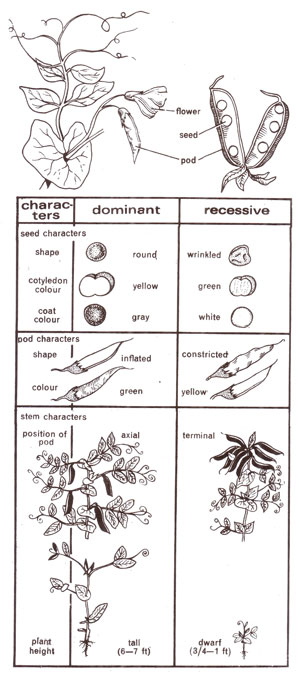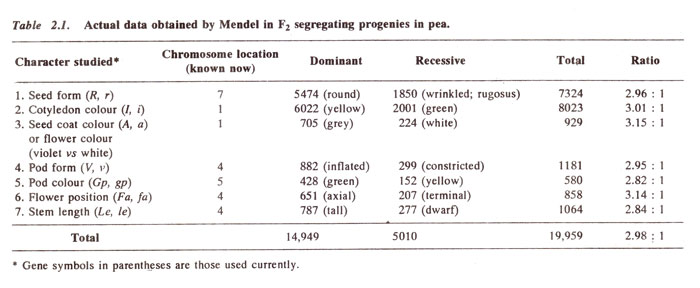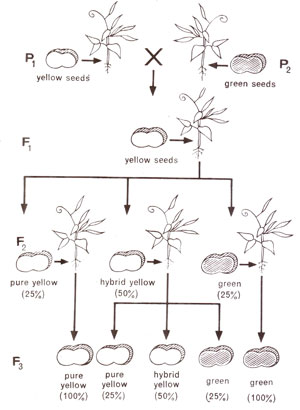Mendel's experiments
- well defined characters,
- bisexual flowers,
- predominantly self-fertilization,
- easy hybridization.
Although hybridization experiments were conducted by earlier workers also as discussed in the previous section, but they considered the individual as a whole complex of characters. Mendel's success was mainly based on the fact that he considered a single character at one time. Seven pairs of contrasting characters were chosen for the study. These characters are shown in Figure 2.1.
Crossing technique
Since garden pea is self-fertilizing, the anthers have to be removed before maturity. This operation of removal of anthers is called emasculation. The stigma is protected against any foreign pollen, with emasculated flower. At the time of pollination, the pollen should be mature and stigma should be receptive.
For each of the seven pairs of characters shown in Figure 2.1, plants with one alternative trait were used as female and those with the other alternative as male. Reciprocal crosses were also made. The population obtained as a result of crossing plants exhibiting contrasting characters is called the first filial generation or F1 (filial means progeny). The progeny of F1 plants obtained due to self-fertilization represents the second filial generation or F2. Similarly F3, F4, etc. can also be obtained.
Mendel presented the data and conclusions derived from his experiments in a paper entitled "Experiments in Plant Hybridization" which was read before the Briinn Natural History Society in 1865 and was published in the proceedings of the society in 1866. This paper, was though prepared as a lecture rather than as a research publication, contained Mendel's hypothesis concerning the mechanism of inheritance.
Mendel's results can be explained using a specific example. When tall plants were crossed with dwarf plants, all plants in the F1 generation were tall. The plants used in the initial cross are referred to as P1 and P2 or parents. When the F1 plants were self-fertilized, both tall and dwarf plants were obtained in the F2 generation. The tall and dwarf plants were obtained in a ratio close to 3 : 1. Similar patterns were obtained for other six pairs of characters also.
- For any character the F1 individuals derived from crosses, between two different varieties having alternative characters, showed only one of the traits and never the other. This feature was expressed as dominance of one trait over the other. The trait which appeared in the F1 generation was called dominant and the other which did not appear in the F1 population was called recessive.
- It did not matter which parent variety provided the pollen and which provided the eggs; the results were always the same. In other words, the reciprocal crosses gave the same results.
The dominant-recessive relationships of the seven pairs of characters are shown in Figure 2.1. The results obtained by Mendel with respect to seven pairs of characters are listed in Table 2.1. The results presented in Table 2.1 indicate that a definite 3 : 1 ratio was obtained in each case in the F2 generation. The determining agent responsible for each trait was called a 'factor'. Since the recessive trait was not seen in the F1 generation but reappeared in F2, Mendel could predict the results to be expected in F3. This will be illustrated with the help of an example.
The results expected by Mendel as outlined in Figure 2.2 were actually obtained in the F3 generation for five of the seven pairs of characters studied.







